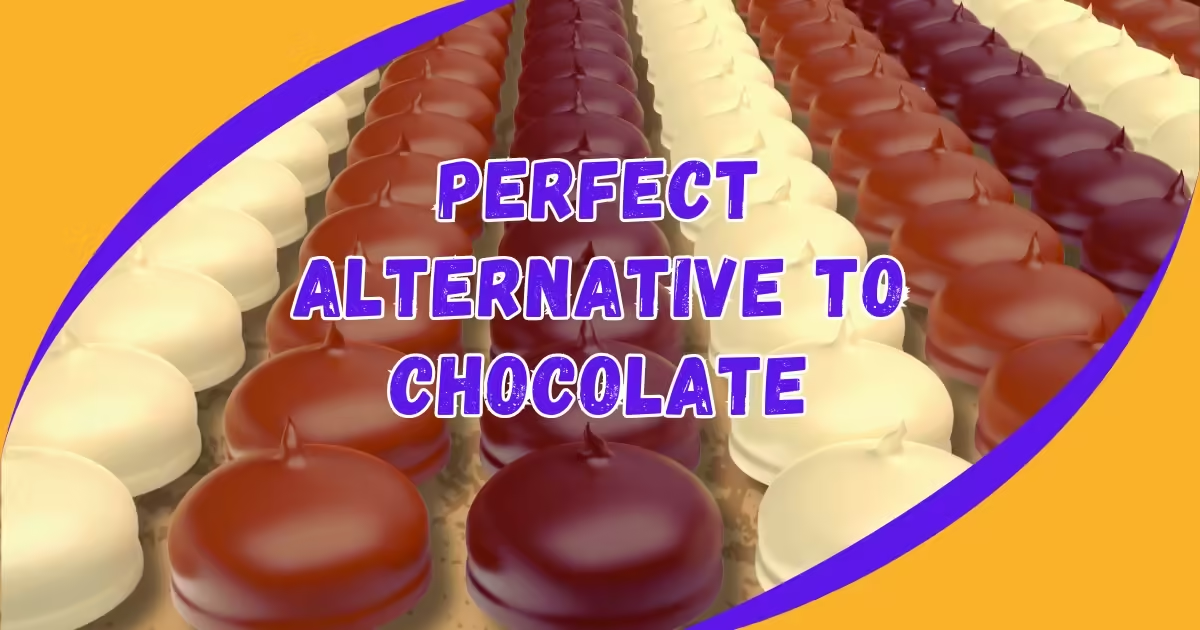Whether you’re a professional pastry chef or a home baker, you’ve likely come across confectionery coating as an alternative to traditional chocolate. This versatile ingredient is known for its ease of use and ability to set quickly, making it a favorite for dipping, molding, and candy-making. While it lacks the cocoa butter found in real chocolate, this coating offers several advantages that make it an excellent choice for specific projects. In this blog post, we’ll cover 5 reasons why it’s perfect for your baking needs, how it differs from chocolate, and tips for using it successfully in your kitchen..
What is Confectionery Coating? A Simple Guide to Understanding This Baking Staple
Also referred to as compound chocolate or candy melts, is a chocolate-like product that is used primarily in baking and candy-making. Unlike real chocolate, which contains cocoa butter, confectionery coating uses vegetable fats or oils, making it easier to melt and work with. The vegetable fats allow the coating to set quickly and maintain its shape without the need for tempering, a process that is often required when working with traditional chocolate.
Key Ingredients in Confectionery Coating
- Sugar: Provides sweetness and the familiar flavor of chocolate.
- Vegetable Fats: Replace cocoa butter, making the coating easier to melt and use.
- Milk Solids: Add creaminess and texture.
- Cocoa Powder: In some versions, cocoa powder is added to give the coating a chocolate-like taste.
- Emulsifiers: Help stabilize the ingredients and ensure a smooth texture.
This ingredient is widely popular due to its ease of use and versatility. It’s perfect for anyone looking for a reliable option without the technical challenges that come with handling real chocolate.
Confectionery Coating vs Chocolate: What’s the Difference?
Understanding the differences between these two ingredients is important when deciding what to use for your baking needs. Although they may look and taste similar, their ingredients and behaviors when melted or cooled are not the same.
1. Ingredients
- Chocolate contains cocoa butter, which is what gives it its smooth texture and signature mouthfeel. Cocoa butter requires careful tempering to achieve the right shine and snap.
- Confectionery coating, on the other hand, replaces cocoa butter with vegetable fats, making it easier to melt without the need for tempering.
2. Melting and Tempering
One of the main reasons bakers prefer this option over chocolate is the simplicity of use. While chocolate requires tempering to prevent blooming (the white streaks that can appear), this coating can be melted and used straight away without any need for tempering.
Taste and Texture:
While the flavor mimics chocolate, the absence of cocoa butter means the taste lacks some depth. Similarly, the texture isn’t as rich and creamy as traditional chocolate.
How to Use Confectionery Coating for Dipping and Molding
Confectionery coating is perfect for a variety of tasks, including dipping fruits, cookies, or candies and molding decorative shapes. Its ease of use and quick-setting properties make it a go-to option for both professionals and hobbyists.
Step-by-Step Guide for Using Confectionery Coating
- Melt the Coating: Place the desired amount in a microwave-safe bowl. Heat it in 30-second intervals, stirring in between, until it’s fully melted. You can also use a double boiler for more controlled heating.
- Prepare the Items to Be Dipped: Make sure the items you plan to dip (e.g., pretzels, cookies, or fruit) are dry, as moisture can cause the coating to seize.
- Dip or Mold: Dip your item into the melted coating, ensuring it’s fully coated. For molding, pour the melted coating into a silicone mold and tap gently to release air bubbles.
- Let It Set: Place the dipped items or filled molds onto a parchment-lined tray and allow the coating to set. It typically sets quickly at room temperature, but you can also refrigerate for faster results.
- Decorate: Once the coating has set, you can add decorations, drizzle with contrasting colors, or dust with edible glitter to elevate your creations.
It is incredibly versatile, whether you’re making chocolate-covered strawberries or crafting intricate designs for a special event. The quick-setting nature of the coating allows you to work efficiently without waiting for long drying times.
Popular Types of Confectionery Coating and When to Use Them
1. White Coating
White confectionery coating is ideal for projects where you want a blank canvas for decoration or need to add vibrant colors using food coloring. It is often used for cake pops, truffles, or to coat cookies with a clean, neutral base.
2. Milk Chocolate-Flavored Coating
A great option for those who love the taste of milk chocolate but need something that’s easier to work with. Ideal for dipping fruits or creating molds.
3. Dark Chocolate-Flavored Coating
Dark chocolate-flavored coating offers a richer, more intense flavor compared to its milk chocolate counterpart. Use this coating when you want a bolder chocolate flavor, such as for coating nuts, pretzels, or creating molded candies with a sophisticated look.
4. Colored Confectionery Coating
You can find pre-colored confectionery coatings in shades like red, blue, and green, making them ideal for holiday treats, themed parties, or decorative purposes. These coatings are particularly popular for cake pops or customized chocolates that match event colors.
How to Properly Melt and Temper Confectionery Coating
Although confectionery coating doesn’t require the tempering process that traditional chocolate does, there are a few tips to ensure it melts smoothly and doesn’t become grainy or too thick.
1. Avoid Overheating
Available in a variety of colors can scorch easily if overheated. When microwaving, use short bursts of 15-30 seconds and stir between intervals to ensure even heating. For a more controlled melt, consider using a double boiler, where indirect heat prevents scorching.
2. Add Shortening if Needed
If your coating becomes too thick during melting, you can add a small amount of vegetable shortening to thin it out. Start with a teaspoon, adding more as needed, until the coating reaches a smooth, dippable consistency.
3. Avoid Water
Even a small amount of water can cause confectionery- coating to seize and become unusable. Make sure that all tools, bowls, and items to be dipped are completely dry before use.
4. Keep It Warm
If you’re working on a large project, consider keeping the coating warm by placing it over a warm water bath (double boiler-style) to maintain the ideal consistency for dipping or drizzling.
Common Problems with Confectionery Coating and How to Fix Them
Confectionery coating is relatively easy to work with, but sometimes issues arise. Here are some common problems and how to fix them.
1. Coating Too Thick
If your confectionery coating is too thick, you can add a small amount of vegetable shortening to thin it out. Make sure to stir the mixture thoroughly and keep heating it gently until the consistency improves.
2. Uneven Texture
If your coating looks lumpy or uneven, it’s likely due to improper melting. Always melt the coating slowly and stir it frequently to ensure a smooth texture.
3. Dull Finish
If your confectionery coating doesn’t have the glossy finish you were hoping for, it may have been overheated or cooled too quickly. Make sure to heat the coating gradually and avoid drastic temperature changes.
4. Coating Cracks
Coating that cracks after setting is usually due to the items being dipped being too cold. Ensure that dipped items are at room temperature before coating them to avoid cracks from temperature shock.
Top Uses of Confectionery Coating in Candy Making and Baking
This coating is a versatile ingredient with many uses in the kitchen. Whether you’re making homemade treats or decorating baked goods, it provides a convenient, easy-to-melt, and professional-looking finish for your creations.
1. Dipping
Use confectionery coating for dipping cake pops, cookies, marshmallows, pretzels, or fruits. Its quick-setting nature makes it perfect for creating shiny, hard coatings on a variety of sweet treats.
2. Molding
This coating is commonly used in molds to create chocolates, candies, and themed decorations. Because it sets quickly without tempering, it’s a favorite among bakers and confectioners for creating smooth, glossy shapes.
3. Drizzling
You can melt confectionery coating and use it to drizzle over cakes, brownies, or cupcakes for a decorative finish. It’s also great for adding a contrasting color or flavor to desserts by drizzling white or colored coating over dark treats.
4. Decorating
Many bakers use colored confectionery coating to create decorative designs on cookies, cakes, and other desserts. It can be piped, painted, or spread onto baked goods to add creative flair and intricate detailing.
5. Filling
For candy making, the coating can be used as a filling or base layer for truffles, bonbons, or other confectionery items. Its smooth texture and mild flavor make it an excellent foundation for adding layers of taste and design.
If you’re looking to elevate your candy-making game even further, learn how to preserve the deliciousness of your creations with our guide on how to freeze dry candy!
Conclusion: Why Confectionery Coating is a Must-Have for Every Baker
The versatility, ease of use, and reliable results of confectionery coating make it a staple ingredient for bakers and candy makers alike. Whether you’re dipping strawberries, molding festive chocolates, or creating custom treats for special occasions, This coating provides an accessible and professional-looking finish that anyone can achieve. Its ability to melt smoothly, set quickly, and eliminate the need for tempering makes it a convenient alternative to traditional chocolate while still delivering satisfying taste and texture.
By following the guidelines outlined in this post, you can avoid common pitfalls and get the most out of this versatile ingredient. From its many flavors and colors to its wide-ranging uses, confectionery coating is an indispensable tool in any kitchen.
FAQs About Confectionery Coating
- What is confectionery coating?
Confectionery coating is a chocolate-like product made with vegetable fats instead of cocoa butter, designed for easier melting and setting. - How does confectionery coating differ from real chocolate?
Confectionery coating contains vegetable fats instead of cocoa butter, meaning it doesn’t require tempering like real chocolate. - Can I use confectionery coating for dipping?
Yes, confectionery coating is perfect for dipping fruits, cookies, cake pops, and other treats due to its quick-setting properties. - How do I melt confectionery coating?
Melt confectionery coating using short bursts in the microwave or over a double boiler, stirring frequently to prevent scorching. - Why is my confectionery coating too thick?
If your coating is too thick, add a small amount of vegetable shortening to thin it to the desired consistency. - Can I use confectionery coating in molds?
Yes, confectionery coating is ideal for molds, as it sets quickly and creates a smooth, glossy finish for candies and chocolates. - Does confectionery coating taste like chocolate?
Confectionery coating mimics the flavor of chocolate but lacks the depth and richness of real chocolate due to the absence of cocoa butter. It has a milder, sweeter taste. - Can I color confectionery coating?
Yes, you can add oil-based food coloring to white confectionery coating to create custom colors. Avoid water-based food colorings, as they can cause the coating to seize. - How do I store leftover confectionery coating?
Store leftover confectionery coating in an airtight container in a cool, dry place. It can be remelted and reused for future projects. - What can I do if my confectionery coating cracks after setting?
Cracking often occurs when the items being coated are too cold. Allow them to come to room temperature before dipping to prevent cracks from temperature differences.

Joseph Bush is a seasoned writer and researcher with over 7 years of experience covering a wide range of general topics, from lifestyle and technology to business and current events. He is dedicated to producing fact-checked, reader-friendly content that informs, engages, and empowers readers.
Throughout his career, Joseph has followed strict editorial guidelines, relied on reputable sources, and ensured every article meets the highest standards of accuracy and clarity. His expertise spans multiple fields, allowing him to explain complex topics in a way that’s easy to understand.
Passionate about continuous learning, Joseph stays updated on industry trends and best practices to deliver trustworthy, well-rounded insights. Readers can rely on his work for its credibility, depth, and real-world relevance.




